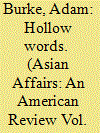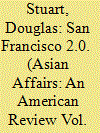| Srl | Item |
| 1 |
ID:
117650


|
|
|
|
|
| Publication |
2012.
|
| Summary/Abstract |
Many foreign aid agencies promote peacebuilding as a global policy objective. This paper considers how they have fared in practice in subnational, "peripheral" conflicts in Asia that have relatively low international profiles, using case material from Aceh in Indonesia, the Far South of Thailand, and Sri Lanka. Foreign aid has supported long-term economic growth in these countries but typically failed to address peacebuilding concerns or associated inequalities between ethnic groups. Many barriers limit the scope to promote peacebuilding, stemming from recipient governments' reluctance to accept external involvement and from aid agencies' own limitations. Those agencies that do address conflict concerns tend not to use technical peacebuilding tools or methodologies. Instead, they prioritize the root causes of conflicts, recognizing human rights protection and equality of opportunity as policy aims. They also devise responses locally, build good relationships with governments, and work incrementally from a strong knowledge base. Wider adoption of similar policy objectives and practice would enable further small-scale peacebuilding initiatives.
|
|
|
|
|
|
|
|
|
|
|
|
|
|
|
|
| 2 |
ID:
117651


|
|
|
|
|
| Publication |
2012.
|
| Summary/Abstract |
This is the third time that American policy makers have considered a pivot to Asia. This time is different, however, because it is clear that the base of gravity of the global economy is shifting from West to East. As the most powerful nation in the Asia-Pacific, the United States has an overriding national interest in the preservation of regional prosperity and order. But Washington recognizes that it can no longer impose solutions on the major governments in the region. A new U.S. strategy for the Asia-Pacific will have to take into account the very strict limits imposed on U.S. foreign and defense policies by America's relative economic decline. This means that Washington will have to convince its friends and allies to take greater responsibility for regional security. The so-called San Francisco system of U.S.-sponsored alliances will have to be transformed, in order to make it more responsive to the problems that confront America and its regional friends and allies. This essay will draw upon Joseph Nye's concept of ideal and material resources to assess the viability and adaptability of the San Francisco system. It will also consider the merits of the Pentagon's proposed AirSea Battle concept as a response to Chinese military modernization and as a source of reassurance for Washington's regional friends and allies.
|
|
|
|
|
|
|
|
|
|
|
|
|
|
|
|